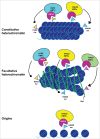Association of ORCA/LRWD1 with repressive histone methyl transferases mediates heterochromatin organization
- PMID: 26765314
- PMCID: PMC4915504
- DOI: 10.1080/19491034.2015.1102814
Association of ORCA/LRWD1 with repressive histone methyl transferases mediates heterochromatin organization
Abstract
Heterochromatin mostly constitutes tightly packaged DNA, decorated with repressive histone marks, including histone H3 methylated at lysine 9, histone H4 methylated at lysine 20 and histone H3 methylated at lysine 27. Each of these marks is incorporated by specific histone lysine methyl transferases. While constitutive heterochromatin enriched with H3K9me3 and H4K20me3 occur within repetitive elements, including centromeres and telomeres, the facultative heterochromatin resides on the inactive X-chromosome and contains H3K27me3 mark. Origin recognition complex-associated (ORCA/LRWD1) protein is required for the initiation of DNA replication and also plays crucial roles in heterochromatin organization. ORCA associates with constitutive and facultative heterochromatin in human cells and binds to repressive histone marks. We demonstrate that ORCA binds to multiple repressive histone methyl transferases including G9a, GLP, Suv39h1 (H3K9me2/3), Suv420h1/h2 (H4K20me2/3) and EZH2 (H3K27me3). Removal of ORCA from human cells causes aberrations in the chromatin architecture. We propose that ORCA acts as a scaffold protein that enables the formation of multiple histone lysine methyltransferase complexes at heterochromatic sites thereby facilitating chromatin organization.
Keywords: ORCA/LRWD1; heterochromatin; histone methyl transferases; replication.
Figures



Comment on
- doi: 10.7554/eLife.06496
Similar articles
-
The preRC protein ORCA organizes heterochromatin by assembling histone H3 lysine 9 methyltransferases on chromatin.Elife. 2015 Apr 29;4:e06496. doi: 10.7554/eLife.06496. Elife. 2015. PMID: 25922909 Free PMC article.
-
Temporal association of ORCA/LRWD1 to late-firing origins during G1 dictates heterochromatin replication and organization.Nucleic Acids Res. 2017 Mar 17;45(5):2490-2502. doi: 10.1093/nar/gkw1211. Nucleic Acids Res. 2017. PMID: 27924004 Free PMC article.
-
Leucine-rich repeat and WD repeat-containing protein 1 is recruited to pericentric heterochromatin by trimethylated lysine 9 of histone H3 and maintains heterochromatin silencing.J Biol Chem. 2012 Apr 27;287(18):15024-33. doi: 10.1074/jbc.M111.337980. Epub 2012 Mar 15. J Biol Chem. 2012. PMID: 22427655 Free PMC article.
-
Heterochromatin assembly: a new twist on an old model.Chromosome Res. 2006;14(1):83-94. doi: 10.1007/s10577-005-1018-1. Chromosome Res. 2006. PMID: 16506098 Review.
-
Phosphorylation of repressive histone code readers by casein kinase 2 plays diverse roles in heterochromatin regulation.J Biochem. 2019 Jul 1;166(1):3-6. doi: 10.1093/jb/mvz045. J Biochem. 2019. PMID: 31198932 Review.
Cited by
-
LRWD1 expression is regulated through DNA methylation in human testicular embryonal carcinoma cells.Basic Clin Androl. 2021 May 20;31(1):12. doi: 10.1186/s12610-021-00130-y. Basic Clin Androl. 2021. PMID: 34011267 Free PMC article.
-
The expanding role of the Ehmt2/G9a complex in neurodevelopment.Neurogenesis (Austin). 2017 May 2;4(1):e1316888. doi: 10.1080/23262133.2017.1316888. eCollection 2017. Neurogenesis (Austin). 2017. PMID: 28596979 Free PMC article.
-
Methylation of histone 4's lysine 20: a critical analysis of the state of the field.Physiol Genomics. 2021 Jan 1;53(1):22-32. doi: 10.1152/physiolgenomics.00128.2020. Epub 2020 Nov 16. Physiol Genomics. 2021. PMID: 33197229 Free PMC article. Review.
-
Chromatin's Influence on Pre-Replication Complex Assembly and Function.Biology (Basel). 2024 Feb 27;13(3):152. doi: 10.3390/biology13030152. Biology (Basel). 2024. PMID: 38534422 Free PMC article. Review.
-
PRSS50 is a testis protease responsible for proper sperm tail formation and function.Development. 2021 Apr 15;148(8):dev197558. doi: 10.1242/dev.197558. Epub 2021 Apr 16. Development. 2021. PMID: 33913480 Free PMC article.
References
-
- Chakraborty A, Shen Z, Prasanth SG. "ORCanization" on heterochromatin: Linking DNA replication initiation to chromatin organization. Epigenetics 2011; 6:665-70; PMID:21586903; http://dx.doi.org/10.4161/epi.6.6.16179 - DOI - PubMed
-
- Li Q, Zhang Z. Linking DNA replication to heterochromatin silencing and epigenetic inheritance. Acta Biochim Biophys Sin 2012; 44:3-13; PMID:22194009; http://dx.doi.org/10.1093/abbs/gmr107 - DOI - PMC - PubMed
-
- Abmayr SM, Workman JL. Holding on through DNA replication: histone modification or modifier? Cell 2012; 150:875-7; PMID:22939615; http://dx.doi.org/10.1016/j.cell.2012.08.006 - DOI - PubMed
-
- Giri S, Prasanth SG. Replicating and transcribing on twisted roads of chromatin. Brief Funct Genomics 2012; 11(3):188-204; PMID:22267489 - PubMed
-
- Bell SP, Dutta A. DNA replication in eukaryotic cells. Annu Rev Biochem 2002; 71:333-74; PMID:12045100; http://dx.doi.org/10.1146/annurev.biochem.71.110601.135425 - DOI - PubMed
Publication types
MeSH terms
Substances
Grants and funding
LinkOut - more resources
Full Text Sources
Other Literature Sources
